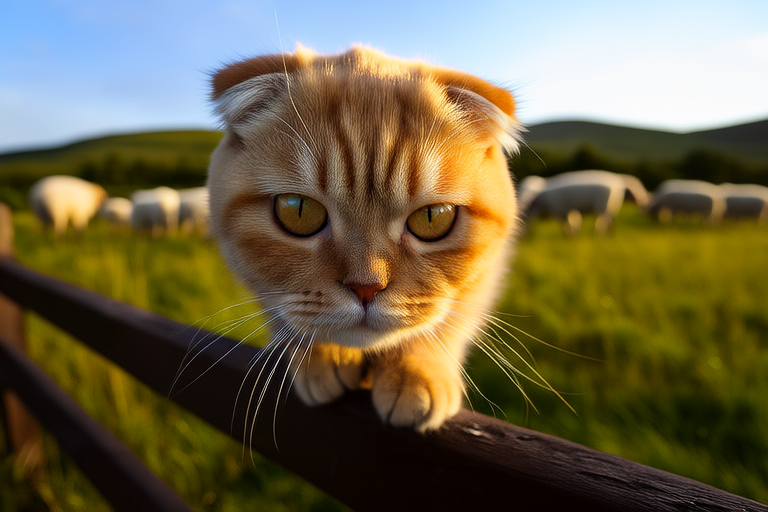From Farm Cat to Internet Sensation: The Remarkable Journey of the Scottish Fold
The Scottish Fold is a breed of cat that has captured the hearts of millions worldwide. From its humble beginnings as a farm cat to its current status as an internet sensation, this breed has seen a remarkable journey. This article explores the origins, physical traits, temperament, care requirements, and health issues of the Scottish Fold, shedding light on why they have become so popular.
Origins and Initial Purpose
The Scottish Fold breed originated in Scotland in the early 1960s. It all began when a barn cat named Susie, who had a natural mutation causing her ears to fold forward, was discovered. William Ross, a neighboring farmer, was fascinated by this unique trait and bred one of Susie’s kittens, a white female named Snooks, to a British Shorthair. The resulting litter included both folded-eared and normal-eared kittens, marking the beginning of the Scottish Fold breed.
Initially, these cats were used on farms to control rodent populations due to their keen hunting skills and adaptable nature. Their intelligence and friendly disposition made them excellent companions for farmers, who valued their ability to thrive in various environments.
Distinctive Physical Traits
The most striking feature of the Scottish Fold is its folded ears, which are caused by a dominant gene mutation. This genetic mutation affects the cartilage of the ear, causing it to fold forward and downwards, giving the cat a distinctively owl-like appearance. The folds can vary in degree, ranging from a slight bend to a tight fold that touches the head. The ears can also be tipped, meaning they are bent at the tips only.
Besides their folded ears, Scottish Folds are medium-sized cats with round faces, large eyes, and short snouts. They have dense, plush coats that come in a variety of colors and patterns, adding to their charm. The breed comes in two coat lengths: short-haired and long-haired, with the latter being less common.
Genetic Implications
The gene responsible for the folded ears is dominant, meaning that if a cat inherits the gene from just one parent, it will exhibit the folded ear trait. However, breeding two Scottish Folds together increases the likelihood of developing osteochondrodysplasia, a condition that causes skeletal deformities and arthritis. As a result, breeders often crossbreed Scottish Folds with other breeds, such as British Shorthairs, to maintain genetic diversity and reduce the risk of health issues.
Transition from Farm Cats to Sought-After Pets
The transition of the Scottish Fold from farm cats to sought-after pets was gradual but significant. As word spread about their unique appearance and friendly nature, more people became interested in owning these cats. In the 1970s, the breed gained recognition in the United States and the United Kingdom, leading to the establishment of formal breeding programs and cat shows where Scottish Folds could be showcased.
Their rise in popularity can also be attributed to their adaptability and ease of care. Scottish Folds are generally healthy cats with relatively few grooming needs, making them ideal for both first-time and experienced cat owners. Additionally, their calm and affectionate demeanor makes them excellent companions for families and individuals alike.
Rise to Internet Fame
The Scottish Fold’s journey to internet fame began in earnest in the mid-2000s when social media platforms like YouTube and Instagram emerged. One of the earliest viral sensations was a video featuring a Scottish Fold named Maru, known for his love of boxes. Maru’s antics quickly gained millions of views, cementing the breed’s reputation as internet stars.
Other notable Scottish Folds include Lil Bub, a famous cat with a unique combination of traits, including folded ears, dwarfism, and polydactyly. Lil Bub’s quirky personality and appearance helped her amass a massive following on social media, further boosting the breed’s popularity. Celebrities like Lady Gaga and Miley Cyrus have also been spotted with Scottish Folds, contributing to their star status.
Temperament, Care Requirements, and Health Issues
Scottish Folds are known for their sweet and gentle personalities. They are highly social and enjoy spending time with their human companions, often seeking out attention and affection. Despite their independent nature, they thrive in environments where they receive regular interaction and mental stimulation. This makes them ideal companions for individuals and families looking for a loving and interactive pet.
Caring for a Scottish Fold involves routine grooming, especially for long-haired varieties, to prevent matting and ensure a healthy coat. Regular brushing and nail trimming are essential, along with routine veterinary check-ups to monitor their overall health. Providing a stimulating environment with toys and scratching posts helps keep them mentally engaged and physically active.
While Scottish Folds are generally healthy, they are prone to certain health issues, including osteochondrodysplasia, polycystic kidney disease, and cardiomyopathy. Early detection and management of these conditions can significantly improve a cat’s quality of life. Regular veterinary visits and a balanced diet are crucial in maintaining their health.
Enduring Popularity and Cultural Impact
The Scottish Fold’s enduring popularity is a testament to its unique appearance and endearing personality. In the digital age, their presence on social media has solidified their status as internet icons, with countless videos, memes, and posts featuring these charming cats. Their cultural impact extends beyond the virtual world, influencing fashion, art, and even advertising.
The breed’s success story serves as an inspiration to those who appreciate the beauty of feline companionship. By highlighting the importance of responsible breeding practices and proper care, the Scottish Fold continues to capture the hearts of cat lovers everywhere, ensuring its place in the annals of feline history.
